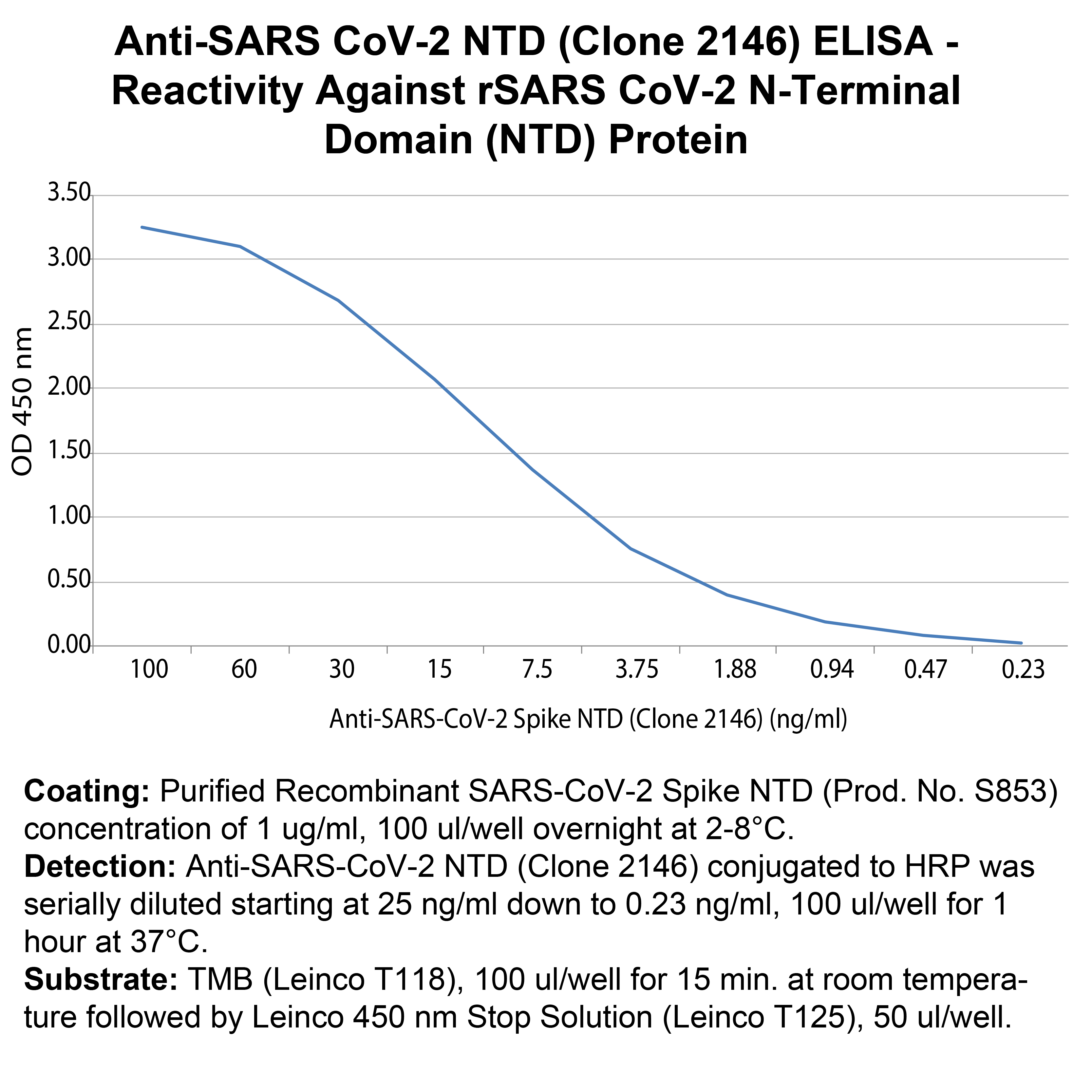Anti-SARS-CoV-2 Spike NTD (Clone 2146) – Biotin
Anti-SARS-CoV-2 Spike NTD (Clone 2146) – Biotin
Product No.: LT2005
- -
- -
Product No.LT2005 Clone 2146 Target SARS-CoV-2 Spike NTD Product Type Recombinant Monoclonal Antibody Alternate Names COV2-2146, SARS-CoV2 Spike NTD, COVID-19, 2019-nCoV, Severe acute respiratory syndrome coronavirus 2, SARS-CoV2 Isotype Human IgG1 Applications ELISA , IHC |
Data
 Coating: Purified Recombinant SARS-CoV-2 Spike NTD (Prod. No. S853) concentration of 1 ug/ml, 100 ul/well overnight at 2-8°C.
Detection: Anti-SARS-CoV-2 NTD (Clone 2146) conjugated to HRP was serially diluted starting at 25 ng/ml down to 0.23 ng/ml, 100 ul/well for 1 hour at 37°C.
Substrate: TMB (Leinco T118), 100 ul/well for 15 min. at room temperature followed by Leinco 450 nm Stop Solution (Leinco T125), 50 ul/well.
Coating: Purified Recombinant SARS-CoV-2 Spike NTD (Prod. No. S853) concentration of 1 ug/ml, 100 ul/well overnight at 2-8°C.
Detection: Anti-SARS-CoV-2 NTD (Clone 2146) conjugated to HRP was serially diluted starting at 25 ng/ml down to 0.23 ng/ml, 100 ul/well for 1 hour at 37°C.
Substrate: TMB (Leinco T118), 100 ul/well for 15 min. at room temperature followed by Leinco 450 nm Stop Solution (Leinco T125), 50 ul/well. - -
- -
Antibody DetailsProduct DetailsReactive Species SARS-CoV-2 ⋅ Virus Expression Host HEK-293 Cells Immunogen Sequenced from human survivors of COVID-19 (SARS-CoV-2) Product Concentration 0.5 mg/ml Formulation This recombinant biotinylated antibody is formulated in 0.01 M phosphate buffered saline (150 mM NaCl) PBS pH 7.4, 1% BSA and 0.09% sodium azide as a preservative. Storage and Handling This biotinylated monoclonal antibody is stable when stored at 2-8°C. Do not freeze. Country of Origin USA Shipping Overnight on Blue Ice RRIDAB_2893937 Applications and Recommended Usage? Quality Tested by Leinco ELISA Additional Applications Reported In Literature ? IHC Each investigator should determine their own optimal working dilution for specific applications. See directions on lot specific datasheets, as information may periodically change. DescriptionSpecificity Anti-SARS-CoV-2 Spike NTD-Biotin, clone 2146, specifically targets an epitope on the SARS-CoV-2 spike protein N-terminal domain. Antigen Distribution The spike NTD is expressed on the surface of the SARS-CoV-2 virus. Background Severe acute respiratory syndrome coronavirus 2 (SARS-CoV-2), the causative agent of coronavirus disease 2019 (COVID-19), is an enveloped, single-stranded, positive-sense RNA virus that belongs to the Coronaviridae family 1. The SARS-CoV-2 genome, which shares 79.6% identity with SARS-CoV, encodes four essential structural proteins: the spike (S), envelope (E), membrane (M), and nucleocapsid protein (N) 2. The S protein is a transmembrane, homotrimeric, class I fusion glycoprotein that mediates viral attachment, fusion, and entry into host cells 3. Each ~180 kDa monomer contains two functional subunits, S1 (~700 a.a) and S2 (~600 a.a), that mediate viral attachment and membrane fusion, respectively. S1 contains two major domains, the N-terminal (NTD) and C-terminal domains (CTD). In both SARS-CoV and SARS-CoV-2, the CTD contains the receptor-binding domain (RBD), which binds to the angiotensin-converting enzyme 2 (ACE2) receptor on host cells3-5. The NTD of SARS-CoV-2 does not bind to ACE26, and the function of NTD in SARS-CoV-2 infection is not well understood. In other CoVs, the NTD may promote attachment by binding to sugar moieties7 and might play a role in the conformational change of S2 required for membrane fusion8. While most neutralizing antibodies target the RBD domain and block receptor binding, potent neutralizing antibodies targeting NTD were isolated from convalescent COVID19 patients9, identifying the NTD as an attractive candidate for vaccines and therapeutics. In addition, the NTD is a promising antigen for diagnostic tests, as there is only 53.5% homology between the NTD of SARS-CoV-2 and SARS-CoV10. Antigen DetailsPubMed NCBI Gene Bank ID Research Area COVID-19 . Seasonal and Respiratory Infections . Viral References & Citations1. Zhou, P., Yang, X., Wang, X. et al. Nature 579, 270–273. 2020. 2. Wu, F., Zhao, S., Yu, B. et al. Nature 579, 265–269. 2020. 3. Wrapp D, Wang N, Corbett KS, et al. bioRxiv. 2020. 4. Walls AC, Park YJ, Tortorici MA, et al. Cell. 181(2):281-292.e6. 2020. 5. Li W, Zhang C, Sui J, et al. EMBO J. 24(8):1634-1643. 2020. 6. Wang Q, Zhang Y, Wu L, et al. Cell. 181(4):894-904.e9. 2020. 7. Park, Y., Walls, A.C., Wang, Z. et al. Nat Struct Mol Biol 26, 1151–1157. 2019. 8. Zhou, H., Chen, Y., Zhang, S. et al. Nat Commun 10, 3068. 2019. 9. Chi X, Yan R, Zhang J, et al. Science. eabc6952. 2020. 10. Ou, X., Liu, Y., Lei, X. et al. Nat Commun 11, 1620. 2020. Technical Protocols |
Formats Available
- -
- -
Prod No. | Description |
|---|---|
LT2005 | |
LT2000 | |
LT2010 |
 Products are for research use only. Not for use in diagnostic or therapeutic procedures.
Products are for research use only. Not for use in diagnostic or therapeutic procedures.


